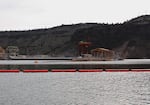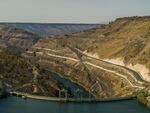
FILE: The Deschutes River Alliance blames water quality issues on a tower behind Round Butte Dam that mixes water bound for the Lower Deschutes River.
Amanda Peacher / OPB
The advocacy group Deschutes River Alliance says the Oregon Department of Environmental Quality is failing to enforce water quality standards on the Lower Deschutes River and that the ecosystem is suffering because of it.
The group, which calls itself a voice for the Lower Deschutes, says the river has regularly violated standards for acidity or pH, dissolved oxygen and temperature that operators of the Pelton Round Butte hydroelectric dam project near Madras are required to maintain under the rules of their state permit.
But DEQ says the dam operators — Portland General Electric and the Confederated Tribes of the Warm Springs Reservation — are in full compliance with water quality rules and that the dams may not be the sole cause of the river’s declining health.
The lower river has in recent years seen an explosion of harmful algae and shrinking runs of salmon and steelhead. The Deschutes River Alliance places the blame squarely on a $110 million tower that mixes water from the Lake Billy Chinook reservoir before sending it through the dams and into the Lower Deschutes.
“There is, we believe, a direct correlation between the operation of the dam and the health of the river,” said Sarah Cloud, executive director of the Deschutes River Alliance.
Lake Billy Chinook is where the Metolius, Middle Deschutes and Crooked rivers meet behind Round Butte Dam.
The coldest, cleanest water in the lake comes mostly from the Metolius and sinks to the bottom of the reservoir. Water from the Crooked River, which is warmer and heavily polluted by agricultural runoff, floats closer to the surface of Lake Billy Chinook.
Before the water-mixing tower was installed in 2009, Lake Billy Chinook had only one outlet, which was deep in the reservoir. That meant mostly cold bottom water was making it through the dams and into the Lower Deschutes.
“It had the consequence where we were discharging into the Lower Deschutes artificially cold water in the spring,” said Megan Hill, natural resources manager for PGE. “And then we ran out of that cold water, and we were discharging too-warm water in the later summer.”

FILE: The Pelton Dam is part of a hydroelectric project that environmental advocates say has created temperature and water quality issues on the Lower Deschutes River.
Courtesy of PGE
PGE and the Warm Springs Tribes installed the tower to better regulate water temperature in the Lower Deschutes by mixing cold bottom water with warm surface water.
Hill said the tower has helped achieve year-round temperatures closer to what existed before the dams were constructed in the 1950s and ‘60s — slightly increasing spring temperatures and decreasing them later in the summer.
“And that’s good for the fish downstream,” Hill said.
However, the Deschutes River Alliance says dam operators have for years drawn too much polluted Crooked River water in their mix, which has fueled algae on the Lower Deschutes and starved it of oxygen.
Cloud said the intense drought last summer limited agriculture on the Crooked and ultimately led to a slight improvement in water quality on the Lower Deschutes.
“We don’t want to have to rely on drought to save the Lower Deschutes River,” Cloud said. “We’d prefer to see changes in operations at the tower.”
The Deschutes River Alliance has led a yearslong campaign to influence tower operations, which the group says will ultimately benefit the lower river. Most notably, the group filed a Clean Water Act lawsuit against PGE and the Warm Springs Tribes that was ultimately dismissed because of the tribes’ sovereign immunity.
More recently, the Deschutes River Alliance has lodged water quality complaints with Oregon DEQ and the state Environmental Quality Commission, which is DEQ’s rulemaking body appointed by the governor. The group says DEQ is not strictly enforcing dissolved oxygen, temperature and pH requirements listed in the water quality management and monitoring plan for the Pelton Round Butte Project.
They’re urging the commission to require DEQ to penalize the dam operators for water quality violations.
“The laws are written to protect aquatic life and their biological needs,” Cloud said. “And right now, they’re not being enforced on the Lower Deschutes River, which is causing harm to the aquatic life there.”
DEQ spokesperson Laura Gleim said in an email that dissolved oxygen and temperature measurements immediately downstream of the dams meet the requirements of PGE and the Tribes’ operating permit.
Gleim said that the pH of the Lower Deschutes immediately downstream of the dams does occasionally exceed the operational requirement, but added that the dam project and mixing tower may not be the culprit, or not the only one.
DEQ has listed parts of the Lower Deschutes watershed as “impaired” under the Clean Water Act because of water quality issues.
The agency will eventually set a pollution limit known as a “Total Maximum Daily Load” to better control the pH, or the acidity, of the water. That will require DEQ to identify various contributors to the river’s high pH, including the Pelton Round Butte Project.


